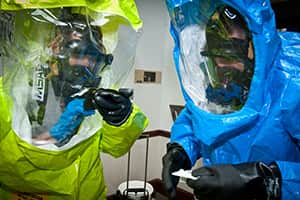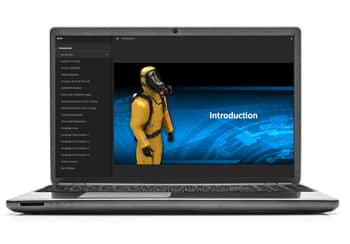What Topics are Covered in 40-Hour OSHA HAZWOPER Training?
Occupational Safety and Health Administration (OSHA) outlines employer compliance requirements regarding Hazardous Waste Operations and Emergency Response (HAZWOPER) contained within 29 CFR 1910.120.

Within those regulations, training requirements are addressed in 1910.120(e). Specifically, in 1910.120 (e)(3)(i), it addresses 40 hours of off-site instruction required for workers engaged in hazardous substance removal or other activities which expose or potentially expose workers to hazardous substances and health hazards at or above the Permissible Exposure Limit (PEL).
So, what topics are covered in a 40-hour OSHA HAZWOPER training course? How do employers know if the training content utilized is compliant with the OSHA HAZWOPER standard? Two immediate reference points from the standard itself should be considered - Appendix C and Appendix E.
Appendix C- Compliance Guidelines
Specifically, in Section 2, training topics for both general and specialist employees are addressed. The following is an excerpt for general workers: The training programs for employees subject to the requirements of paragraph (e) of this standard should address:
- Safety and health hazards employees should expect to find on hazardous waste clean-up sites;
- What control measures or techniques are effective for those hazards;
- What monitoring procedures are effective in characterizing exposure levels;
- What makes an effective employer's safety and health program;
- What a site safety and health plan should include;
- Hands on training with personal protective equipment and clothing they may be expected to use
- The contents of the OSHA standard relevant to the employee's duties and function
- Employee's responsibilities under OSHA and other regulations
- Supervisors will need training in their responsibilities under the safety and health program and its subject areas such as the spill containment program, the personal protective equipment program, the medical surveillance program, the emergency response plan, and other areas
Of course, these are very generalized topics.
Appendix E- Training Curriculum Guidelines
For more specific curriculum information, consult Appendix E- Training Curriculum Guidelines.
Not only does this appendix address employer-specific training plans, but it also provides requirement details on regulatory knowledge, technical knowledge, and technical skills for initial, refresher, and on-site training topics.
With respect to the above two references, and when it comes to OSHA HAZWOPER training, employers can exercise several options. They may choose to develop their own training programs with internal resources, purchase packaged in-person or technology-based training products, or utilize a combination of these resources.
40-Hour HAZWOPER Training from NET
In addition, if employers choose National Environmental Trainer's 40-Hour HAZWOPER Online Training Course, the specific table of contents for that course reflects the following:

Introduction
- Describe HAZWOPER standards.
- Identify HAZWOPER training requirements.
Hazard Communication
- Describe the Hazard Communication Standard.
- Identify how employers inform employees of hazardous chemicals at a job site.
- Describe the importance of the Globally Harmonized System of Classification and Labeling of Chemicals.
- Identify health and physical hazards associated with chemicals.
- Describe the purpose of a safety data sheet.
- List the sections of a safety data sheet.
Roles and Responsibilities
- Describe how to prepare a key personnel portion of the site-specific health and safety plan.
- Identify an individual who has the authority to direct all activities.
- Identify the other personnel needed for the project and assign their general functions and responsibilities.
- Show lines of authority, responsibility, and means of contact.
- List optional personnel to include in the site-specific health and safety plan.
HAZWOPER Sites and Zones
- Describe the primary purpose for established site control zones at a hazardous materials incident.
- Describe how a site map is used as part of a site control program.
- List the major steps in site preparation prior to any cleanup activities.
- List three frequently used HAZWOPER Site Work Zones.
- Describe the function of a hotline and buddy system.
General Health and Safety Plan Guidelines
- Describe how to ensure that everyone who enters a site is aware of the health and safety guidelines.
- Describe the precautions to take to prevent work injury.
- List the precautions to take when working with tools and heavy equipment.
Identifying Hazardous Substances
- List hazardous substances.
- List types of aerosols.
- Describe boiling point, vapor pressure, flash point, vapor density, and pH.
- Describe why vapor density is important.
- List types of oxidizers.
- Define lower and upper explosive limits.
Hazard Recognition
- Describe how conditions at a waste site could result in worker hazards.
- Describe the importance of accident or exposure prevention.
- List types of chemical physical hazards.
- Describe how to prevent electrical accidents.
- Describe work practices to minimize infection from bloodborne pathogens.
- List characteristics of lock and tag devices.
Respiratory Protection
- Describe the respiratory protection program.
- List types of respirators.
- List respiratory equipment.
- Describe how air-purifying respirators operate.
- List types of cartridges used in an air-purifying respirator.
- Describe how to use a self-contained breathing apparatus.
- Describe when to use a supplied-air respirator.
- Describe how to determine the protection factor of a respirator.
- Describe how to test a respirator fitting.
Decontamination Plans and Managing Emergencies
- Describe the parts of a decontamination plan.
- Describe methods of minimizing worker contact with hazardous waste.
- Describe the decontamination procedures during medical emergencies.
Decontamination of Personnel, Persistent Contamination, and Disposal
- Describe the layout of a personnel decontamination station.
- Describe the factors that determine the extent of decontamination required.
- List the decontamination procedures.
- Describe what to do if the decontamination procedure does not work.
- Describe decontamination facility designs.
Drums
- Describe how to inspect drums.
- List the equipment used to move drums.
- Describe how to enhance the efficiency and safety of drum-opening.
- List incompatible chemicals.
- Describe how a staging area is used for bulking and shipping drums.
Introduction to Confined Spaces
- Define confined space.
- List types of confined spaces.
- Describe how to predict hazards in confined spaces.
- List causes of fatalities in confined spaces.
Confined Spaces Pre-Entry and Protective Device Control
- List the key components of confined space safety.
- Describe the elements of a confined space entry plan.
- Describe the air test process.
- List the elements of a confined space permit.
- List the steps for preparing the confined space for entry.
- Describe how to use protective devices, controls, and monitoring in confined space entry.
Compressed Gas Cylinders
- List types of compressed gases.
- Describe how to identify a compressed gas cylinder.
- Describe the hazards of compressed gases.
- Explain gas cylinder storage procedures.
- Describe how to safely open a valve.
- Describe what to do if a cylinder is leaking.
- Describe how to move a cylinder.
Toxicology
- List known toxic effects of chemicals and other hazardous substances.
- Describe the different routes of exposure of toxic chemicals.
- List the chemical classifications.
- Describe the effects of chemical exposure to the body.
- Describe how toxins interact with other chemicals and toxins.
- Describe how to protect yourself from toxins.
Chemical Awareness
- Describe how chemical safety is communicated.
- Describe how concentration impacts the strength of a chemical.
- List the types of chemical hazards.
- List the do's and don'ts for solvents.
- Describe how to protect yourself from oxidizers.
- Describe the characteristics of chemical hazards.
- List the forms of radioactive contamination.
- Describe how to protect yourself from radiation exposure.
Air Monitoring
- Describe what the data obtained from air monitoring is useful for.
- List the factors used to choose a sampling instrument.
- Describe how to calibrate an instrument.
- Describe how to monitor catalytic combustion, oxygen availability, combustibility, and toxic atmospheric monitors.
- Describe how to monitor and detect radiation.
- Define active and passive samplers.
Site Characterization
- Describe the phases of site characterization.
- List what should be included in parameter reconnaissance.
- Describe the steps needed before entering a hazardous site.
- Explain how documentation and documentation control is used when monitoring a hazardous site.
Hazardous Materials Sampling
- Describe what is needed for a sampling plan.
- List what qualifies as a chain of custody.
- List the tools used for soil sampling.
- Describe the process for underground and surface water sampling.
- List the tools used for container opening.
- List the do's and don'ts for container sampling.
Personal Protective Equipment
- Describe how personal protective equipment (PPE) can cause work hazards.
- Describe the type of PPE training required by workers.
- List the levels of PPE.
- Describe when different levels of PPE should be worn.
Wearing Personal Protective Equipment
- Describe the different types of protective clothing.
- Describe how to inspect and select protective clothing.
- List what may impact work duration.
- Describe how to safely use personal protective equipment (PPE).
- Describe how PPE can influence heat-related illness.
- Describe the general requirements for PPE.
Site Emergencies
- List work site and waste site related emergencies.
- Describe how a contingency plan is developed.
- List the organizational structure in the chain of command.
- Describe how to use internal and external communication.
- List what should be included in site mapping.
- Describe how to create an evacuation route.
Excavations
- Describe the general requirements for excavations.
- Describe the roles and responsibilities of the competent person.
- List the soil classifications.
- List the options for protective systems.
- Describe the different shoring systems.
Medical Surveillance
- Describe the importance of a medical surveillance program.
- List what should be included in a medical surveillance program.
- Describe how to develop a site-specific medical program.
- Describe the importance of periodic medical screening.
- List what medical records should be kept.
Emergency Response Procedures and Documentation
- List emergency response procedures.
- Describe the follow-up procedures for emergencies.
- Describe how to document emergency responses.
If you are required to take 40-Hour HAZWOPER training, get started today with National Environmental Trainers.

